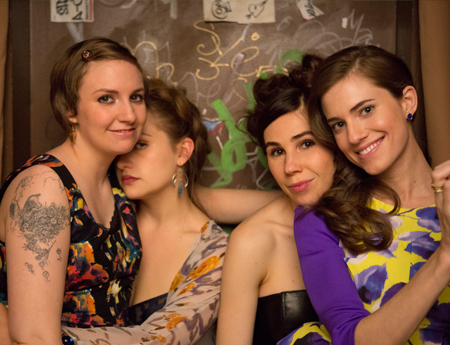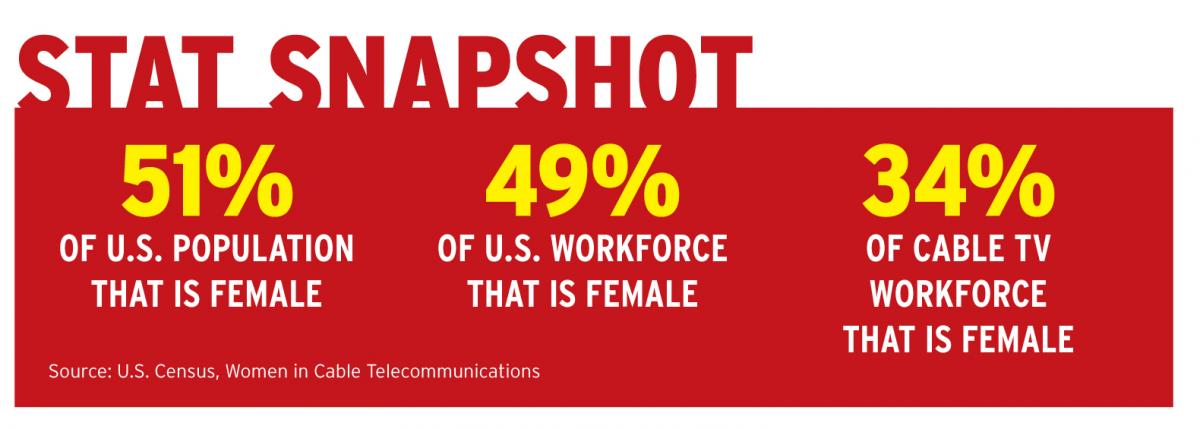You’ve Come a Long Way, Maybe

Women in TV: How 20 Companies Stack Up
An intense debate erupted online and on Twitter in February about HBO’s True Detective, and the way women were represented onscreen—when they were there at all.
The New Yorker’s Emily Nussbaum and Huffington Post TV critic Maureen Ryan led the assault. Ryan noted “a familiar array of cable-drama types: ‘crazy’ mistresses, nameless strippers, randy hookups, disgruntled daughters and dismayed wives” in the show. But she took it far beyond one series, examining industry data to assess how the fact that most showrunners are male (and white) influences the kinds of stories viewers see on HBO, Showtime, AMC, FX and other prestige outlets.
Ryan reported that in the past 12 years, from Jan. 1, 2002 to April 15, 2014, of the 90 people who created or wrote one-hour dramas, 10 were identified as white women; and only one was a woman of color. Those findings were startling to many but longtime observers of the industry were not surprised.
The broader employment picture is also less than inspiring. Women in Cable Telecommunications (WICT) in Washington, DC has been measuring employment for women in the cable industry for a decade through its PAR initiative, tracking pay equity, advancement opportunity and resources for work-life integration for women.
WICT’s just-published report for 2014 reveals the number of full-time female employees in the cable telecommunications industry is lower today than it was 10 years ago (34% in 2013 versus 39% in 2003), while the percentage of executives and senior level managers has ticked up over that same period (28% in 2013 versus 27% in 2003). While it’s a tiny increase, noted WICT president and CEO Maria Brennan, “there were times that it has gone lower.
The smarter way to stay on top of broadcasting and cable industry. Sign up below
“Where we start to get nervous is when we look at full-time employees,” Brennan said. “In 2003, women constituted 39% of the full-time employees, and in 2013 women now constitute 34%. Unless we do some course correction and these workforce dynamics continue, we could see an overall level of women in the managerial ranks decline from 36% to 35% over the next five years.”

And on April 14, the Writers Guild of America released a report showing a dip in the number of employed female writers from 28% in 2009 to 27% in 2012. Female writers, the WGA said, made 82 cents for every dollar earned by male writers, up from 77 cents in 2009. (President Obama this month signed an executive order promoting transparency on pay after the Senate blocked the Paycheck Fairness Act. He called it an “embarrassment” that a disparity persists.)
“What you have to commit a large amount of money to and an ongoing amount of resources to says something about your priorities,” Ryan told B&C. “Something like Game of Thrones is a commitment of many years and tens of millions of dollars, and anything of that nature is generally put in the hands of white men.”
Widen the scope to include drama and comedy series at the cable and broadcast networks and at Netflix, and the picture isn’t much different. A 2013 survey by The Hollywood Reporter found that only 14 of the top 50 showrunners were women, and many of those work in teams with men.
These numbers persist even though women now make up over 50% of the American population, and over 49% of the workforce, according to an April 2013 report from the U.S. Census Bureau. That reality would appear counterproductive for most corporate media companies to ignore.
“As a commercial entity in America right now, if you want to be successful I don’t know how you sustain” the gender skew, Ryan said. “I just hope that’s not a model that people continue to pursue because it seems like you’re bypassing your potential customer [base] and bypassing a lot of potentially interesting storytellers. If they expand their fields beyond their immediate roster, the talent is there.”
Linking the gender makeup of the industry to the portrayal of women on screen is always tricky. Still, it seems fair to say that showrunners create what they know. While both men and women can and do create great characters of different genders, research has shown that people tend to be most comfortable working with those who fit their demographic profile. The effect of that dynamic is under increasing scrutiny.
Change Takes Time
And yet, social change is slow. Changing culture and media can take generations, cautions Martha Lauzen, PhD., executive director for the Study of Women in Television and Film at San Diego State University. Lauzen conducts annual studies on employment for women in working behind the scenes of TV as well as in independent and studio film.
“If you look back at the summer of 2000,” Lauzen says, “the NAACP got together with other groups, and it seemed that over the course of that summer there were articles every week about the poor representation of people of color in television. I think it was genuinely embarrassing to people in the industry. They do not want to be called racists. But they don’t mind being called sexist.”
Case in point: according to the most recent study, women creators, writers, producers, directors of photography, and editors made up 28% of the workforce in primetime network television entertainment shows during the 2012-13 season—a two percent increase since the 2011-12 report. Examine the stats over 17 consecutive seasons and the upturn is a mere 9% since 1997-98, when women constituted 19% of these roles.
Of these seven behind-the-scenes occupations, women were the most prevalent among producers, constituting 38 percent of that group in 2012-13—a 9 percent increase from 29% in 1997-98, the same percentage rate women held these positions in 2006-2007.
WICT has used the PAR Initiative to work closely with cable operators and programmers to develop educational events and programs, including the Betsy Magness Leadership Program, and to recognize industry professionals at the manager and director levels who have demonstrated through its Rising Leaders Program.
In March, WICT announced 180 women who will take part in the program from companies including AMC Networks, Disney/ESPN, Weather Channel, Scripps Networks Interactive and Viacom. The weeklong development program is designed to prepare them for increased leadership responsibilities when they return to the workplace.
“Our mission is to get the best women in the industry ready to lead,” said Brennan.
Overall stats are important, but then there is the question of industry juice. Which women could be described as truly driving the business? There are several—among the top tier would be figures like Nancy Dubuc, who rose nearly a year ago to CEO of A+E Networks, or Bonnie Hammer, who was minted in a recent Comcast reorg as chairman of the NBCUniversal Cable Entertainment Group.
In the entertainment business, however, nothing is forever. Anne Sweeney, the co-chairman of Disney Media Networks and president of Disney/ABC Television Group, had a long run as a highly influential exec but recently announced she will leave her post next February to try her hand at TV directing.
Board seats are another tricky area. At Disney, three of the 10 directors are women, still a better mix than at Comcast, where only one of 12 is female.
Craig Robinson, executive VP and chief diversity officer at NBCUniversal, says the company’s portfolio reaches 95% of American women each month, making it all the more important for it to have women in key exec roles. “Businesses ignore the female consumer at their own peril – according to some research, women account for more than half of all online retail spending, 80% of healthcare spending and almost 70% of new car purchases,” he says.
If you look closely at the corporate leadership ladders at many of the top public media companies we examined, you quickly see that there are sometimes no women at all.
“It’s always easy to believe that we have made more progress than we have when you look at the lower level jobs that have very little power,” said Jennifer Pozner, director of Women Media & News in New York, and author of Reality Bites Back: The Troubling Truth About Guilty Pleasure TV. “When you look at actual agenda-setting jobs, in news or in entertainment, women don’t normally have those jobs.”
The key, she said, is breaking down the structural biases that exclude women, people of color and a diversity of ideas in key echelons of the business.
“Yes, we’ve made it in some ways—but progress does not mean equity,” Pozner said. “The way we get there is tackling the structural issues…breaking up the monopoly, and through a healthier, more competitive and more democratic set of policies to allow media companies to have more owners and more diversity and more competition.”
Janice Rhoshalle Littlejohn is a Los Angeles-based journalist and author.
